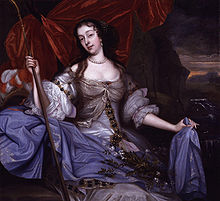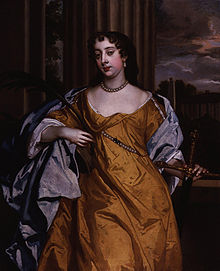- Barbara Palmer, 1st Duchess of Cleveland
-
Barbara Palmer, Duchess of Cleveland 
Portrait by John Michael Wright (c. 1670). Lady of the Bedchamber In office 1663-1673 Predecessor Katherine Stanhope, Countess of Chesterfield Successor Barbara Howard, Countess of Suffolk Spouse Roger Palmer, 1st Earl of Castlemaine
Robert FieldingPartners Philip Stanhope, 2nd Earl of Chesterfield
King Charles II of England
John Churchill, 1st Duke of MarlboroughIssue Anne Lennard, Countess of Sussex
Charles FitzRoy, 2nd Duke of Cleveland
Henry FitzRoy, 1st Duke of Grafton
Charlotte Lee, Countess of Lichfield
George FitzRoy, 1st Duke of Northumberland
Barbara FitzRoyFather William Villiers, 2nd Viscount Grandison Mother Mary Bayning Born 27 November 1640 (17 November Old Style)
Parish of St. Margaret's, Westminster, London, EnglandDied 9 October 1709 (aged 68)
Chiswick Mall, ChiswickReligion Anglican; converted to Roman Catholicism Barbara Palmer, 1st Duchess of Cleveland (27 November [O.S. 17 November] 1640[1] – 9 October 1709) was an English courtesan and perhaps the most notorious of the many mistresses of King Charles II of England, by whom she had five children, all of which were acknowledged and subsequently ennobled. Her influence was so great that she has been referred to as "The Uncrowned Queen."[2] Her immediate contemporary was Madame de Montespan, mistress of King Louis XIV of France.
Barbara was the subject of many portraits, in particular by court painter Sir Peter Lely. Her extravagance, foul temper and promiscuity provoked diarist John Evelyn into describing her as the "curse of the nation".
She converted to Roman Catholicism from Anglicanism in 1663.
Contents
Early life
Born Barbara Villiers at the parish of St. Margaret's, Westminster, London, she was the only child of the 2nd Viscount Grandison, William Villiers (a half-nephew of the 1st Duke of Buckingham), and his wife, Mary Bayning, heiress of the 1st Viscount Bayning. On 20 September 1643, her father died in the English Civil War from a wound sustained at the Battle of Newbury while fighting for the Royalists. He had spent his considerable fortune on horses and ammunition for his Cavalier regiment; his widow and daughter were left in straitened circumstances. Shortly after Lord Grandison's death, Barbara's mother the Lady Mary remarried to Charles Villiers, 2nd Earl of Anglesey, a cousin of her late husband.[3]
Upon the 1649 execution of King Charles I, the impoverished Villiers clan secretly transferred their loyalty to his son, Charles. Every year on 29 May, the new King's birthday, young Barbara, along with her family, descended to the cellar of their home in total darkness and clandestinely drank to his health.[4] At that time, Charles was wandering about the Continent, exiled and penniless.
King's mistress
Tall, voluptuous, with masses of auburn hair, slanting, heavy-lidded blue-violet eyes, alabaster skin, and a sensuous, sulky mouth,[5] Barbara Villiers was considered to be one of the most beautiful of the Royalist women, but her lack of fortune left her with reduced marriage prospects. Her first serious romance was with Philip Stanhope, 2nd Earl of Chesterfield, but he was searching for a rich wife; he would wed Elizabeth Butler in 1660.[6][7] On 14 April 1659 she married Roger Palmer (later 1st Earl of Castlemaine) against his family's wishes; his father predicted that she would make him one of the most miserable men in the world. Palmer was a Roman Catholic. The two separated in 1662, following the birth of her first son. They remained married for his lifetime, but it is believed that Palmer did not father any of his wife's children. [1]
Barbara became King Charles's mistress in 1660, while still married to Palmer, and whilst Charles was still in exile at The Hague. The Palmers had joined the ambitious group of supplicants who sailed for Brussels at the end of 1659.[8] As a reward for her services, the King created her husband Baron Limerick and Earl of Castlemaine in 1661. In many contemporary accounts, including Pepys's Diary, she is referred to as "Lady Castlemaine".
Of her six children, five were acknowledged by Charles as his:
- Lady Anne Palmer, later FitzRoy (1661–1722), probably daughter of Charles II, although some people believed she bore a resemblance to the Earl of Chesterfield. She later became the Countess of Sussex.
- Charles Palmer, later FitzRoy (1662–1730), styled Lord Limerick and later Earl of Southampton, created Duke of Southampton (1675), later 2nd Duke of Cleveland (1709)
- Henry FitzRoy (1663–1690), created Earl of Euston (1672) and Duke of Grafton (1675)
- Charlotte FitzRoy (1664–1718), later Countess of Lichfield. She gave birth to twenty children.
- George FitzRoy (1665–1716), created Earl of Northumberland (1674) and Duke of Northumberland (1683)
- Barbara (Benedicta) FitzRoy (1672–1737) - Barbara Villiers claimed that she was Charles' daughter, but she was probably the child of her mother's second cousin and lover, John Churchill, later Duke of Marlborough
Lady of the Bedchamber
By 1662, Barbara, the King's mistress, had more influence at the court than his queen consort, Catherine of Braganza. In point of fact, Barbara chose to give birth to their second child at Hampton Court Palace while he and the Queen were honeymooning.[9] In the summer of 1662 she was appointed Lady of the Bedchamber despite opposition from Queen Catherine and Edward Hyde, 1st Earl of Clarendon, one advisor to the King and a bitter enemy of Barbara's. Behind closed doors, Barbara and the Queen feuded constantly.
Barbara's influence over the King waxed and waned. Her victory in being appointed as Lady of the Bedchamber was followed by rumours of an estrangement between her and the King, the result of his infatuation with Frances Stuart. In December 1663, Barbara announced her conversion to Roman Catholicism. Historians disagree as to why she did so. Some believe it was an attempt to consolidate her position with the King, and some believe it was a way of strengthening her ties with her Catholic husband.
In June 1670 Charles created her Baroness Nonsuch (as she was the owner of Nonsuch Palace). She was also, briefly, granted the ownership of Phoenix Park in Dublin as a present from the King. She was made Countess of Castlemaine and Duchess of Cleveland in her own right. However, no one at court was sure if this was an indication that she was being jettisoned by Charles, or whether this was a sign that she was even higher in his favours. The dukedom was made with a special remainder which allowed it to be passed to her eldest son, Charles FitzRoy, despite his illegitimacy.
Character
Barbara was known for her dual nature. Diarist John Evelyn called her "the curse of the nation";[10] yet, others described her as great fun, keeping a good table and with a heart to match her famous temper. Lady Barbara took advantage of her influence over the King, using it to her own benefit. She would help herself to money from the Privy Purse and take bribes from the Spanish and the French. She was famously extravagant and promiscuous. She also meddled in politics, supporting the Second Dutch War (declared in February 1665), along with most of the court and Parliament.[11] But there are accounts of exceptional kindness from Barbara; once, after a scaffold had fallen onto a crowd of people at the theatre, she rushed to assist an injured child, and was the only court lady to have done so.[12]
Downfall
While the King had taken other mistresses, the most notable being the actress Nell Gwynne, Barbara took other lovers too, including the acrobat Jacob Hall and her second cousin John Churchill. Her lovers benefited financially from the arrangement; Churchill purchased an annuity with £5,000 Barbara gave him. As the result of the 1673 Test Act, which essentially banned Catholics from holding office, Barbara lost her position as Lady of the Bedchamber, and the King cast her aside completely from her position as mistress, taking Louise de Kéroualle as his newest "favourite."
In 1676 she travelled to Paris with her four youngest children, but returned to England four years later. After Charles II's death in 1685, Barbara, aged forty-five, began an affair with Cardonell Goodman, an actor of terrible reputation, and in March 1686 she gave birth his child.[13] In 1705 Roger Palmer died, and she married Major-General Robert "Beau" Fielding, an unscrupulous fortune-hunter whom she later had prosecuted for bigamy. She died at the age of 68 on 9 October 1709 at Chiswick Mall after suffering from an oedema, known at the time as dropsy.
Descendants
Barbara had many notable descendants, including Diana, Princess of Wales, Sir Anthony Eden, British Prime Minister from 1955 to 1957 and Serena Armstrong-Jones, Viscountess Linley.
In literature
- Barbara is the protagonist in the book Royal Harlot (2007) by Susan Holloway Scott.
- Barbara Villiers figures prominently in Bernard Shaw's play In Good King Charles's Golden Days.
- Barbara is the protagonist in Royal Mistress, by Patricia Campbell Horton (1977)
- Barbara Palmer née Villiers, as Countess of Castlemaine, features prominently in Kathleen Winsor's scandalous 1944 bestseller Forever Amber.
- Barbara features largely in A Health Unto His Majesty, by Jean Plaidy (1956)
In film and television
- In the 1911 film, Sweet Nell of Old Drury, Barbara is played by Agnes Keogh
- In the 1922 film, The Glorious Adventure, Barbara is played by Elizabeth Beerbohm
- In the 1926 film, Nell Gwynne, Barbara is played by Juliette Compton
- In the 1934 film, Colonel Blood, Barbara is played by Anne Grey
- In the 1947 film, Forever Amber, Barbara is played by Natalie Draper
- In the 1969 mini-series, The First Churchills, Barbara is played by Moira Redmond
- In the 1974 TV series, Churchill's People, Barbara is played by Diana Rayworth
- In the 1989 film, The Lady And The Highwayman, Barbara is played by Emma Samms
- In the 1995 film, England, My England, Barbara is played by Letitia Dean
- In the 2003 mini-series, Charles II: The Power & The Passion, Barbara is played by Helen McCrory
- In the 2009 film, Broadside, Barbara is played by Antonia Kinley
Ancestry
Ancestors of Barbara Palmer, 1st Duchess of Cleveland William Villiers Sir George Villiers Coletta Clarke Sir Edward Villiers William Saunders Audrey Saunders Dorothy Young William Villiers, 2nd Viscount Grandison Nicholas St. John Sir John St. John Elizabeth Blount Barbara St. John Sir Walter Hungerford Lucy Hungerford Anne Dormer Barbara Villiers Richard Baninge (Bayning) Paul Bayning Ann Barker Paul Bayning, 1st Viscount Bayning Edward Norden Susanna Norden Hon. Mary Bayning Sir Thomas Glemham Sir Henry Glemham Amy Parker Anne Glemham Thomas Sackville, 1st Earl of Dorset Lady Anne Sackville Cecily Baker References
- ^ The Complete Peerage
- ^ William de Redman Greenman Romances of the Peerage, p.1 Reprinted online http://www.archive.org/stream/romancesofpeerag00greeiala/romancesofpeerag00greeiala_djvu.txt
- ^ Margaret Gilmour The Great Lady, pp.9-10
- ^ Gilmour, p.10
- ^ Antonia Fraser "King Charles II" p.209
- ^ www.thePeerage.com
- ^ Stirnet.com
- ^ Gilmour, p.15
- ^ Gilmour, p.75
- ^ Antonia Fraser King Charles II, p.208
- ^ Fraser, pp.230-231.
- ^ Fraser, p.209
- ^ ThePeerage.com (retrieved 18 June 2011). The gender and fate of the child is unknown.
External links
- Portrait of Barbara Villiers
- Portrait of Barbara Villiers and Charles Fitzroy
- The Diary of Samuel Pepys
Peerage of England New creation Duchess of Cleveland
1st creation
1670–1709Succeeded by
Charles FitzroyCategories:- 1640 births
- 1709 deaths
- British courtesans
- Converts to Roman Catholicism from Anglicanism
- Created suo jure peeresses
- Daughters of viscounts
- Dukes of Cleveland
- English duchesses
- House of Stuart
- Mistresses of Charles II of England
- People from Westminster
- Villiers family
- Deaths from edema
- Ladies of the Bedchamber
Wikimedia Foundation. 2010.

